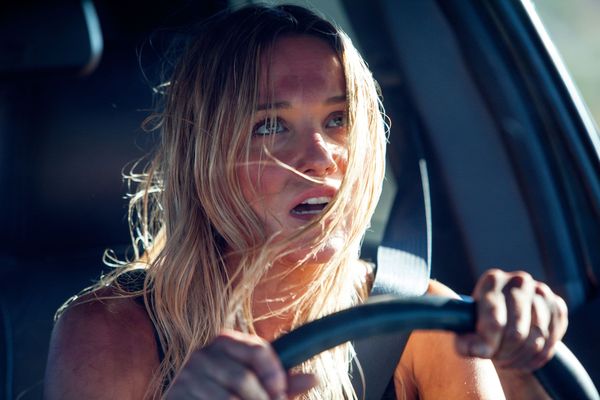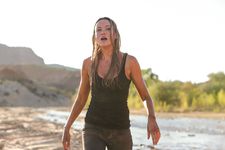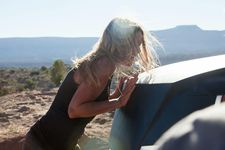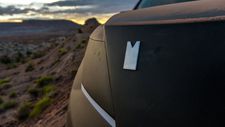 |
| Taking the wheel |
It's a big black beast of a car, the kind of vehicle that makes drivers feel shielded from everyone else on the road. It has its own artificial intelligence, hazard detectors of numerous kinds and even an autopilot. It also has a smartphone app with which it can be operated remotely, but when Sandra's toddler accidentally uses this when she's outside it, on a lonely desert road, they find themselves in serious trouble.
Monolith is a film that perfectly captures the kind of scenario every parent dreads. It's a tough little thriller, pitting its heroine against a hostile environment as she strives to rescue her child, but the sense of desperation it evokes will be familiar to many. Director Ivan Silvestrini, excited to be screening his film at Frightfest, told us something about how it began.
 |
| Taking a stand in the desert |
"I love movies that combine action and emotion. It's hard to find stories that have the right balance between heart and muscles, and when you do, you don't want to let them go," he says. "I felt this story had an enormous potential from the very first read of a small treatment. It was like a roller-coaster of feelings going from the most technological environment to the stone age. I had the chance to explore contemporary themes like our relationship with technology, and more atavistic ones, like the dark feelings of parenthood. And of course, as a writer/director, I couldn't resist the challenge of keeping the audience entertained in such an apparently still situation."
He's credited among four other writers; how much involvement did he actually have at that level?
"I was asked to adapt a comic book treatment into a movie script from the very beginning. I did it with one of the comic's authors [Roberto Recchioni] and then a few more writers joined us during the year it took to actually reach the set (and yes, we kept working on it obsessively until the day before the shooting started). As much as we liked the concept we felt the need to get deeper into the reasons for our character's choices. Me and my co-writer had just become fathers, so I guess the movie can be considered our personal journey through the darkest sides of parenthood. We explored how human desire for protection can become dangerous through technology."
It's a challenging film to take on for a second feature. How confident did he feel about approaching it?
"I believe in 'being prepared'; if you're prepared and you've done your job during pre-production, if you know what you're talking about and what's the core of your movie, you shouldn't be afraid. This job isn't about worrying, you'll always have to face emergencies of any kind. There's no reason to believe everything will be fine, 'cause it never will. You just have to be ready to react, and get the best out of the time you've got.
"I had reasons to be concerned though, you know the golden rule 'avoid animals and children'? Well, the whole movie was shot in three weeks, in the desert, in July, with a couple of 2 year old twins, several beasts, and a very fragile super massive SUV that we couldn’t damage (and of course we did, twice). It was the kind of movie where you’re crazy enough to know that a single day of rain would make it impossible to finish, and yet you make it, during monsoon season (it was actually shot one day after the end of a 10 day non-stop flood in Utah)."
 |
| Taking on the Monolith |
Shooting in desert conditions must have made things difficult too, I suggest, and it seems that it did.
"Once we were shooting a few steps from basecamp and we needed all the manpower we had to make the set safe and fast enough, we shot the scene than we said 'okay, let's go back to basecamp to prepare the next scene'... and well, basecamp wasn't there anymore, a dust devil took it away.
"This is a good example of what it means to face the desert. We had a doctor on set suggesting tricks not to faint. Dehydration was always near. Your body changes in the desert, you could drink eight bottles of water and never go to the restroom for the whole day. You have to move a lot to be close to the action, so you use a little portable monitor, but you need darkness to see it, and umbrellas are not enough sometimes, so you cover yourself under some ridiculous black cloth and every step you make may lead you into some hole in the ground.
"Then there are different kinds of desert, some of them are crumbly so you leave traces if you walk, and the character was supposed to walk in a place nobody goes for a walk to, so we had to study specific paths that won't end up being in any of the shots.
And the list could go on, but it's been amazing just the same, I had never seen places like these Utah spots."
The desert is similarly challenging for the film's heroine, who goes through a lot of changes as a result. How did Ivan work with actress Katrina Bowden to get that right?
"I was very lucky to have her," he says. "We discussed a lot about every moment, every scene had to bring new light (or darkness) to the character. We made some rehearsal, but this is the kind of movie where once you trust your actress, you just have to create the right atmosphere on set and let her perform.
"I like to try different approaches on set once a scene is done, it's a luxury and you don't always have the time for it, but it's interesting to try different variations of the same scene sometimes. They may seem incoherent at first, but in the editing room they can help create something magical that's hard to reach in one take, especially when you have to do a lot of scenes everyday."
The film also required him to coax suitable performances out of children. How did he go about that?
 |
| A car's eye view of the desert |
"When I was writing the script my son was two like Nixon [Hodges, the film's young star], so I knew what I could get and what I probably could not. That's been the trickiest part of the job, every shot you see in the movie, every reaction is the result of a different game we played with the child. I had to invent all these games, sometimes improvise, 'cause they're unpredictable. And you don't wanna torture them, even though you know they'll have to cry sooner or later. Children cry easily, and calm down easily if you know how to talk to them, but there's a point when you lose them, and the day is done. We had two twins, so we switched child when we felt it was enough for him.
"You don't wanna traumatise them, so all the attention is for them. Katrina had to shoot her side of every scene after we knew exactly what we managed to get out of the boys' performances. Sometimes she would shoot on a different week, it took a lot of memory and flexibility to actually make their relationship believable."
I ask what he feels are the most important themes in the film and he say that, for him, it's about dealing with choices. "You think something, say a son, will change your life, and it does but not in the way you wanted. How do you get to love with abnegation someone that took your success away from you? The Monolith puts Sandra in a situation where she has to face her demons. She wanted a car to protect her child? Well, somehow that's exactly what the car is doing by not letting her in."
Has he had any frustrating experiences with cars himself?
"Cars no, children yes," he says. "Technology is no evil in itself, it never is. It's us, and the way we take it for granted."
Being at Frightfest must be a satisfying reward after all that effort.
"I feel lucky and honoured to be here. I just can't wait, the atmosphere seems perfect and the audience is so respectful and curious. Watching your work with an audience is the only moment in the life of a director when you actually realise what you’ve done. You see the movie with their fresh eyes, it’s the only way to get emotional, scared or laugh again at things you’ve seen more than a thousand times."
So what are his future plans?
"Only time will tell," he says. "Right now I’m finishing the script of a dystopian movie I’ve been obsessed with for years about love, sex and artificial intelligence, and I’m developing a uchronic story about a secret mission set in the Jewish Community of Rome during the Nazi occupation in 1943."





















